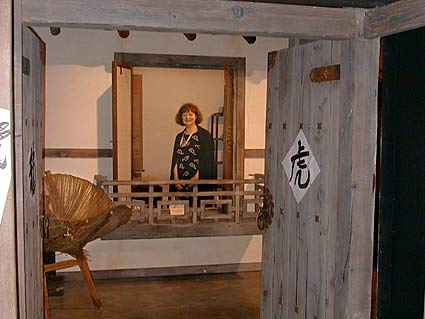
|
Old Korea on display
on Big Isle
HILO » The gate to the courtyard of "Grandfather's House" squeaks when you swing it open, as you might expect at a wooden Korean house built in the 1930s.
But this Korean house was built inside a museum in Newark, N.J., in 1995, moved to another museum in Seattle, then to the basement of the Honolulu Academy of Arts in 2003, and finally to Hilo's Lyman House Museum at the beginning of this year.
Each time the exhibit was rebuilt, artisans kept the signs of wear and tear.
Hilo carpenter Joseph Kim took extra care to be sure that squeak stayed in the gate, said Lyman House director Dolly Strazar. A gate from the 1930s should squeak, Kim told Strazar.
Invitations to 1,400 Big Island teachers went out in March to take a free, preview tour of the exhibit, "Grandfather's House: An Exhibition on Korea." Tomorrow from noon to 4 p.m. will be one of the preview days.
The exhibit, which opened at Lyman House on March 16, is primarily for children from kindergarten through high school.
Fourteen school tours, varying from six to 100 students each, are scheduled for April. Lyman House will display the exhibit for one to two years.
The exhibit is interactive, meaning children and adults can put on Korean clothing and have their pictures taken, which is prohibited in other parts of the museum. They can handle objects like big ceramic jars for storing kim chee.
The hypothetical "grandfather" in this case had enough money to employ a maid who lived in a room at the front gate. She let visitors into the courtyard.
A colorful mural originally painted for the New Jersey exhibit gives a sense of the activity.
Signs of a hard-working lifestyle are everywhere, beginning with the basket at the entrance used to carry items to the house.
A short hallway divides the "sarangbang," the men's quarters, from the "anbang," the women's quarters. Items in the men's quarters suggest they spent time practicing calligraphy, while the women's room suggests sewing.
The kitchen also suggests hard work. It is deliberately dingy from many wood fires. There is no smokestack. Heat was funneled under the floors to warm the house.
[News] [Business] [Features] [Sports] [Editorial] [Do It Electric!]
[Classified Ads] [Search] [Subscribe] [Info] [Letter to Editor]
[Feedback]
